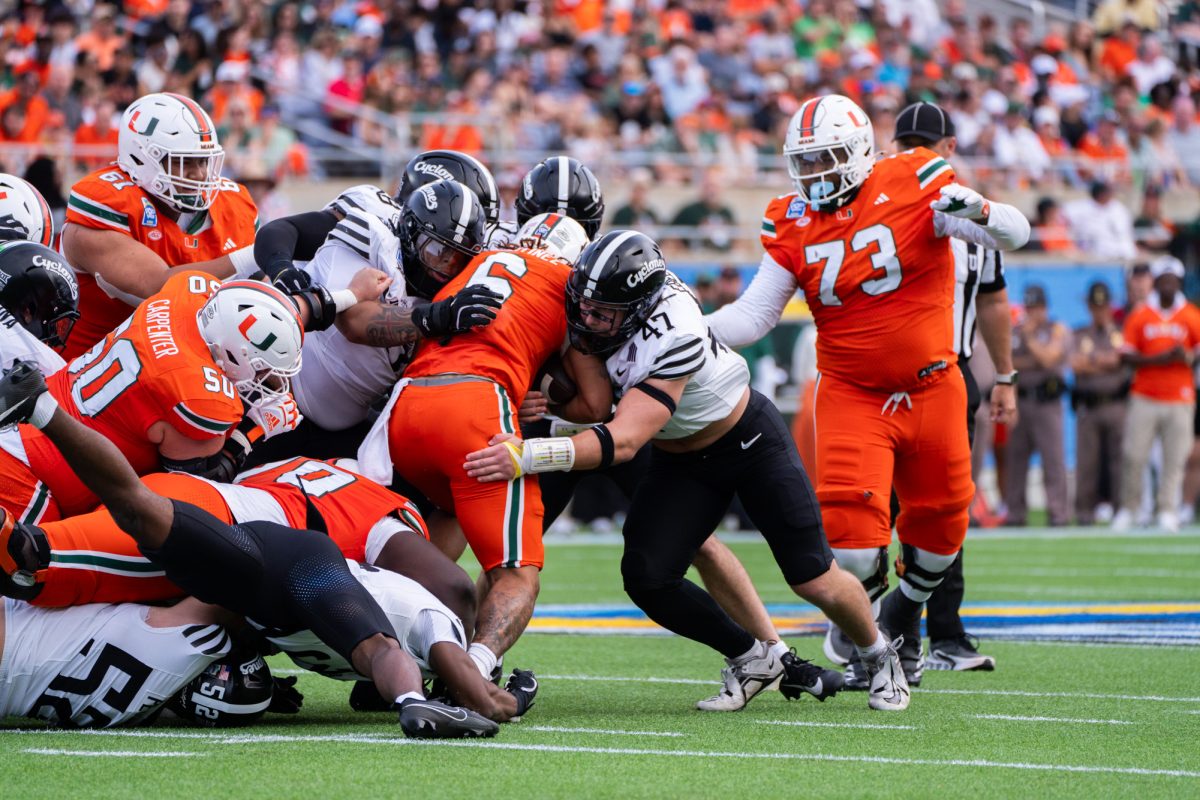Swords, Sorcery and Slander
October 17, 2000
Know, O readers, that between the years that “Pong” was played in darkened living rooms and arcades, and the years of controversy surrounding “Doom,” “Duke Nuke `Em” and “Quake,” there was a game called Dungeons and Dragons dreamed of by Dave Arneson and Gary Gygax.
Dungeons and Dragons (D&D) is the role-playing game that won’t die. The game just turned 26 and shows no sign of rolling its last die in spite of years of controversy, changes in ownership and attacks from religious groups.
D&D was recently purchased by Wizards of the Coast, the people who married gaming with collectible cards to give the world Magic: The Gathering. It recently released a third edition set of rule books for Dungeons and Dragons that it is parading around the country at various major universities in hopes of demystifying the game and bringing it into the mainstream.
The cult classic even caught the eye of New Line Cinema, which will be releasing “Dungeons and Dragons: The Movie” starring the incomparable Jeremy Irons late next year.
Dungeons and Dragons began like a story.
Arneson and Gygax were two old-school war gamers who founded the Studies Rules Association in 1973. Back then, gaming involved historical re-creations and tactical simulations using maps, miniatures and counters. They satisfied a need for historical recreation, but they lacked a storytelling and fantasy element that was becoming more popular in the decade that saw a renewed interest in J.R.R. Tolkien’s “The Lord of the Rings,” Robert E. Howard’s “Conan the Barbarian,” and Michael Moorcock’s “Elric of Melnibone.”
By 1974, Arneson and Gygax had created the first step in a new kind of fantasy simulation: the role-playing game, Dungeons and Dragons.
Dungeon Masters and 20-sided dice
A role-playing game involves creating characters that players take through an adventure created by a referee who sets the stage, tells the tale and makes judgment calls on all the action.
In Dungeons and Dragons, the referee is called Dungeon Master or DM for short. The DM is a story teller who creates an adventure. Players create characters of a variety of classes (fighters, magic users, thieves, etc.) and races (humans, elves, dwarves, etc.) who will populate this world.
Dice stand for random chance and are used to resolve conflict and make choices. For example, a fighter character might engage in combat with a dragon using a sword. Every time that fighter attempts to hit the dragon, he has a chance of failing. This chance is determined by the die. If an attack is successful, damage is determined in the same fashion.
A particular sword might do anywhere from one to 20 points of damage, which can be determined by rolling a 20-sided die. It is simple and not at all arcane.
Stop the heathens!
In the late ’70s, D&D came under fire from Evangelical Christian groups claiming the game contained occult elements, taught children to “cast spells” and promoted Satanism, suicide, sacrifice and murder. In June 1982, high school student Irving Pulling committed suicide after a period of depression.
Pulling played D&D with a teacher. He was depressed that his bid for school council was not going well. He was an admirer of Adolf Hitler, and his mother kept a loaded gun in the house, according to Religioustolerance.org.
Pulling’s mother, Patricia, accused her son’s teacher of “placing a curse” on her son during a game. Pulling’s mother was so convinced of the reality of this curse, she founded Bothered About Dungeons and Dragons (BADD), an organization of concerned parents that petitioned the Consumer Product Safety Commission to place warning labels on copies of Dungeons and Dragons and all other fantasy role-playing games.
Under pressure from BADD, the Commission investigated the game and found nothing hazardous about it. Yet rumors persisted, paranoia mounted, anti-gaming literature was published, games were banned, and a generation of enthusiastic youngsters looking for a creative outlet were stigmatized.
The return of D&D . it must be magic
Now in its third edition, Dungeons and Dragons has been entertaining kids of all ages and troubling the straights for 26 years, a problem that only a good PR campaign can overcome. Enter the Dungeons and Dragons College Tour.
The tour is designed to bring the game into the light for a new generation of gamers and to shed the bad reputation of the past. The tour came to Iowa State last Friday and set up a tent just south of the Campanile from noon to 4 p.m. Those new to D&D as well as veterans of the game came and went all day.
“We’re all about promoting the game as a social game,” said Martin Molloy, account executive for the Guild Group, the public relations firm heading the tour. “There are a lot of misconceptions because people just don’t understand the game.”
Molloy said D&D gained a bad reputation early on because the Studies Rules Association never countered unfounded claims of occultism.
“In the past, rumors started,” he said. “[They] let a lot of those rumors sit because it built the mystique of the game. A game can’t make anyone do anything they weren’t prone to do anyway. We’re letting people see the fun and storytelling aspects of the games.”
One of the features of the new edition that the tour is trying to promote is a simpler system of rules that long-time players and beginners will find easier to deal with.
“The new edition is a lot more novice and user friendly,” Molloy said, “We’ve listened to what game players have been saying for years and incorporated that into the new edition.”
Molloy said the college tour hasn’t run into any of the great opposition the game faced in previous decades, though there have been a few who have stepped up to air their concerns.
“We have run into SOME problems,” he said, “but that was with people who obviously had a problem.”
Those who would be wizards and warriors
David Croak, senior in food sciences, has been playing D&D since he was 10 years old and said that he was far from finding anything sinister about the game; it was actually quite wholesome.
“I started in 1988 when the `Dungeons and Dragons’ cartoon was popular,” he said. “At the time there was a lot of controversy. People were talking about devil worshipping, but it was just a friendly get-together.”
Croak said he has invested at least $500 in D&D books since he started playing, and though the new edition looks good to him, he doesn’t plan to buy it just yet.
“I’m gonna stay with my old collection,” he said.
Josh Newton is a Winterset resident and a member of Dragonwing, a D&D gaming club, who came to Ames to test the new system with those who stopped by the tent. Newton said the new edition is better than the old one, whether a person had been playing for years or has never even heard of the game.
“The third edition is more streamlined,” he said. “It’s a lot easier for new players to learn and for old players, it’s a lot more customized. It makes it a lot more interesting.”
Karen Bovenmyer, graduate student in English, is the vice-president of the Ames Science Fiction Fantasy Association. Bovenmyer said she got into D&D for the social aspects of the game and for the outlet it gave her creative impulses.
“It’s a great creative outlet and a very social game,” she said. “I met my husband at a club meeting.”
Bovenmyer said the rumors surrounding D&D have been there for years and that the game could not be any less sinister.
“There are a lot of people who know nothing about it,” she said. “I’ve never seen anyone flip out. It’s all about stories. If reading books and telling stories is evil, then what are universities for?”






